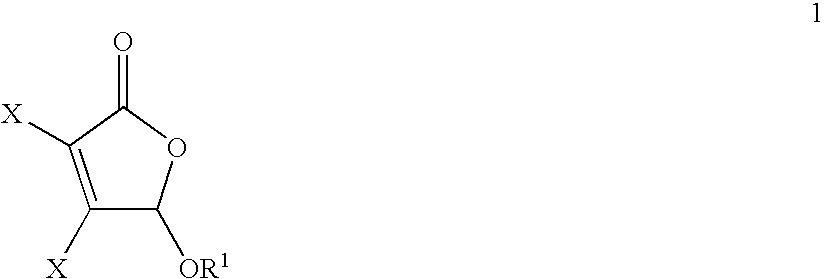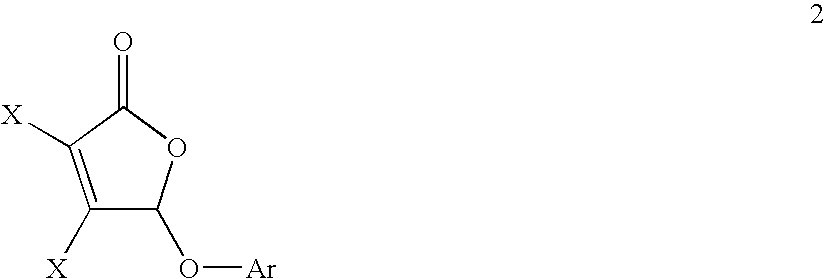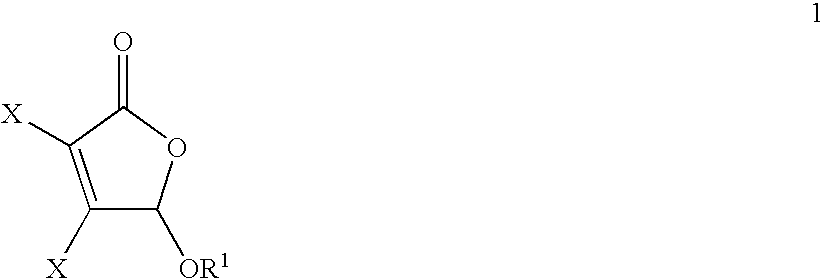Preparation of substituted butenolides via palladium-free etherification and amination of masked mucohalic acids
a technology of mask mucohalic acid and substituted butenolides, which is applied in the field of substituted butenolides preparation by palladium-free etherification and amination of mask mucohalic acids, can solve the problems of high cost of palladium reagents, and difficult preparation of substituted butenolides. achieve the effect of cost saving
- Summary
- Abstract
- Description
- Claims
- Application Information
AI Technical Summary
Benefits of technology
Problems solved by technology
Method used
Image
Examples
example 1
Preparation of 4-methoxycarbonyloxy-2,3-dichloro-2-buten-4-olide
Methyl chloroformate (9.92 g, 105 mmol) was added to a cold (−10° C. to −5° C.) solution of mucochloric acid (16.9 g, 100 mmol) in dry dichloromethane (200 mL). Diisopropylethylamine (14.2 g, 110 mmol) was then added over a 5 min period and the resulting mixture was stirred at −10° C. to −5° C. for 2.5 h. The reaction mixture was quenched with water (200 mL) and diluted with dichloromethane (600 mL). The phases were separated and the red organic phase was washed with water (400 mL). The organic phase was concentrated under reduced pressure. The residue was purified by silica gel column chromatography (ethyl acetate / heptane) followed by recrystallization (ethyl acetate / heptane) to give 4-methoxycarbonyloxy-2,3-dichloro-2-buten-4-olide as an off-white solid: yield 16.2 g (71%). 1H NMR (CDCl3): δ 6.76 (s, 1H), 3.93 (s, 3H). 13C NMR (CDCl3): δ 162.4, 153.6, 146.4, 125.3, 94.4, 56.6. Anal. Calc'd for C6H4Cl2O5: C, 31.75; H...
example 2
Preparation of 4-methoxycarbonyloxy-2,3-dibromo-2-buten-4-olide
Methyl chloroformate (4.96 g, 52.5 mmol) was added to a cold (−10° C. to −5° C.) solution of mucobromic acid (12.9 g, 50.0 mmol) in dry dichloromethane (200 mL). Diisopropylethylamine (7.11 g, 55.5 mmol) was then added over a 10 min period and the resulting mixture was stirred at −10° C. to −5° C. for 1.5 h. The reaction mixture was quenched with water (100 mL) and diluted with dichloromethane (200 mL). The phases were separated and the red organic phase was concentrated under reduced pressure. The residue was purified by silica gel column chromatography (ethyl acetate / heptane) followed by recrystallization (ethyl acetate / heptane) to give 4-methoxycarbonyloxy-2,3-dibromo-2-buten-4-olide as a beige solid: yield 7.17 g (45%). 1H NMR (CDCl3): δ 6.76 (s, 1H), 3.93 (s, 3H). 13C NMR (CDCl3): δ 163.3, 153.6, 141.6, 119.6, 96.6, 56.5. Anal. Calc'd for C6H4Br2O5: C, 22.81; H, 1.28; Br, 50.59. Found: C, 22.75; H, 1.23; Br, 50.88...
example 3
Preparation of 4-t-butyloxycarbonyloxy-2,3-dichloro-2-buten-4-olide
Mucochloric acid (1.69 g, 10.0 mmol), di-t-butyl dicarbonate (2.50 g, 11.5 mmol) and N-methylmorpholine (1.21 g, 12.0 mmol) were combined in dry dichloromethane (50 mL) and stirred at RT for 18 h. The reaction mixture was quenched with water (50 mL) and partitioned between water (20 mL) and dichloromethane (50 mL). The phases were separated and the dark organic phase was concentrated under reduced pressure. The residue was purified by silica gel column chromatography (ethyl acetate / heptane) followed by pulping in heptane to give 4-t-butyloxycarbonyloxy-2,3-dichloro-2-buten-4-olide as a white solid: yield 0.93 g (35%). 1H NMR (CDCl3): δ 6.73 (s, 1H), 1.54 (s, 9H). 13C NMR (CDCl3): δ 162.7, 150.8, 146.7, 93.9, 86.1, 27.8. Anal. Calc'd for C9H10Cl2O5: C, 40.17; H, 3.75; Cl, 26.35. Found: C, 40.33; H, 3.54; Cl, 26.62.
PUM
 Login to View More
Login to View More Abstract
Description
Claims
Application Information
 Login to View More
Login to View More - R&D
- Intellectual Property
- Life Sciences
- Materials
- Tech Scout
- Unparalleled Data Quality
- Higher Quality Content
- 60% Fewer Hallucinations
Browse by: Latest US Patents, China's latest patents, Technical Efficacy Thesaurus, Application Domain, Technology Topic, Popular Technical Reports.
© 2025 PatSnap. All rights reserved.Legal|Privacy policy|Modern Slavery Act Transparency Statement|Sitemap|About US| Contact US: help@patsnap.com



